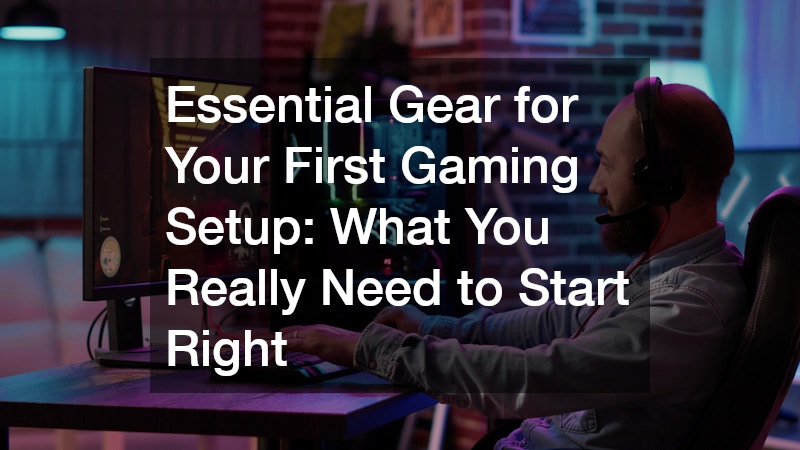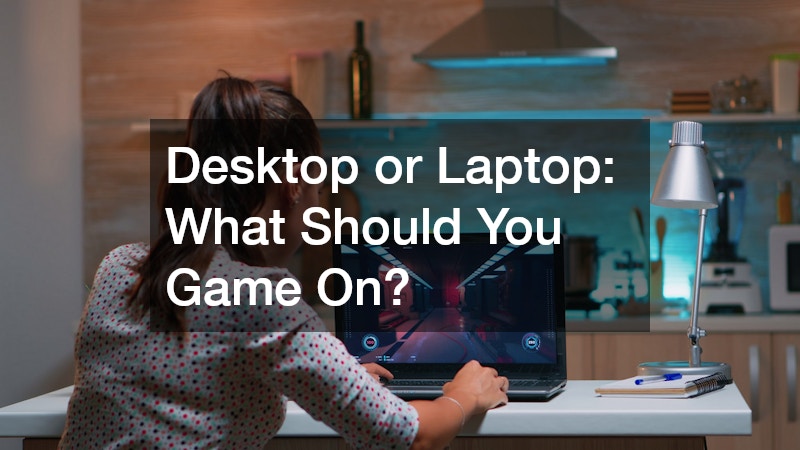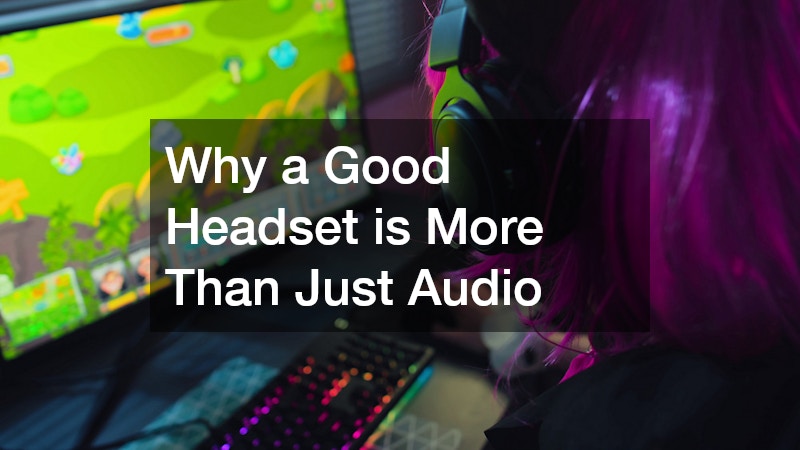Disclaimer: Entertainment News Today. This site provides arts and entertainment content for informational purposes only.
Whether you’re jumping into the world of PC gaming, console domination, or even planning to stream your gameplay, your gaming setup can make or break your experience. With endless gadgets and high-end gear flooding the market, it’s easy to feel overwhelmed — or overspend. But the truth is, starting strong doesn’t have to mean spending thousands. This guide is designed for people obsessed with gaming who want a no-fluff, beginner-friendly checklist of what actually matters in a first gaming setup.
From choosing the right monitor and keyboard to deciding if you need studio-level audio, we’ll walk you through what’s essential — and what can wait. Let’s build your ultimate starter rig, the smart way.
What Kind of Gamer Are You?
Before we dive into the hardware, it’s important to ask yourself: What kind of games do you play and how often? Are you into high-end FPS titles like Call of Duty or Valorant, or do you love cozy indie games like Stardew Valley and Hades? Your answers determine how demanding your setup needs to be.
If you’re gaming casually, a mid-range build or console setup could be perfect. Competitive players or streamers, however, need better specs and more gear to stay ahead.
How to Choose the Right Gaming Monitor
Your monitor is the window into your virtual world. A bad display can ruin even the best games. Don’t let that happen.
Monitor Must-Haves:
- Resolution: 1080p (Full HD) is a great starting point. If your budget allows, consider 1440p (2K) for sharper visuals.
- Refresh Rate: Look for at least 75Hz, but 144Hz is ideal for smoother gameplay in FPS and racing games.
- Response Time: Aim for 1ms to 5ms to reduce ghosting and lag.
- Panel Type: IPS panels offer better color accuracy and viewing angles than TN panels, though TN may have slightly faster response times.
Bonus Tips:
- Use VESA mounts to free up desk space.
- Avoid 4K for your first setup unless you have a powerful GPU to match.
Also, consider screen size and aspect ratio when choosing your monitor. A 24–27-inch screen is ideal for most desks, offering great immersion without overwhelming your space. For competitive gaming, 24 inches is often preferred because it allows you to see more of the action without moving your head. Curved monitors can enhance immersion in single-player or sim games, but they’re less useful in competitive scenes. Additionally, adaptive sync technology like NVIDIA G-Sync or AMD FreeSync helps eliminate screen tearing and stuttering for a smoother experience. These features, while not mandatory, can make your games look and feel much better.
Desktop or Laptop: What Should You Game On?
This comes down to portability vs. performance. Here’s a quick breakdown:
Choose a Desktop If:
- You want the best performance per dollar
- You’re comfortable with upgrading parts over time
- You’ll mostly be gaming at home
Choose a Gaming Laptop If:
- You need portability for school, travel, or shared spaces
- You value an all-in-one solution without external monitors or peripherals
- You’re okay with slightly lower performance at the same price point
Whichever you pick, go for at least 16GB RAM, a mid-tier GPU (like RTX 3060 or AMD equivalent), and an SSD to ensure snappy load times.
Another important factor is cooling. Desktops typically have better airflow and larger cooling systems, which means they run cooler during extended gaming sessions. Gaming laptops, while more compact, often struggle with heat buildup, which can lead to thermal throttling and shorter hardware lifespan if not properly managed. Battery life is also a consideration—most gaming laptops won’t last long unplugged, so plan to stay near a power outlet.
On the flip side, laptops are ideal if you attend LAN parties, move frequently, or prefer gaming from the couch or a coffee shop. Ultimately, it’s about matching your setup to your lifestyle.
What Makes a Great Gaming Keyboard?
Mechanical keyboards are the gold standard in gaming, thanks to their responsiveness, durability, and tactile feedback.
Key Features to Look For:
- Switch Type: Cherry MX (Red for speed, Brown for balance, Blue for clicky feedback)
- Anti-Ghosting & N-Key Rollover: Ensures every keypress registers, even during frantic gameplay
- RGB Backlighting: Looks cool, but also helps in low-light conditions
- Wired vs. Wireless: Wired offers zero input lag; wireless options have improved but still require charging
Optional (but nice to have):
- Programmable macro keys
- Wrist rest for long sessions
- Compact 60% or TKL layouts if desk space is tight
What Mouse Should You Use for Gaming?
Your mouse is your weapon, and precision matters.
Gaming Mouse Essentials:
- DPI Settings: Higher DPI = faster movement. Look for adjustable DPI (minimum 6,000–12,000 DPI).
- Polling Rate: 1000Hz is ideal for responsiveness.
- Ergonomic Design: Especially if you play for long hours.
- Programmable Buttons: Handy for MMOs or assigning macros in FPS games.
- Wired vs. Wireless: Wired is usually preferred by competitive players due to zero lag, but wireless tech has come a long way (e.g., Logitech G Pro X Superlight).
Pair your mouse with a quality mousepad for better control and durability.
Why a Good Headset is More Than Just Audio
In gaming, hearing footsteps, gun reloads, and voice cues can give you the upper hand. A solid headset isn’t just immersive — it’s tactical.
Gaming Headset Features to Prioritize:
- Surround Sound (Virtual 7.1 or 3D Audio): Ideal for competitive shooters and RPGs.
- Clear Microphone: Communication is key in team games. Look for noise-canceling mics or detachable boom mics.
- Comfort: Over-ear designs with breathable ear cushions are best for marathon sessions.
- Compatibility: USB or 3.5mm jack options work for both PC and console.
Prefer speakers? They’re okay for solo play or casual gaming, but they lack the directional sound critical in competitive titles.
Is a Gaming Chair Really Necessary?
Short answer: yes, if you game often.
Gaming chairs offer better lumbar support, posture alignment, and adjustability than a typical office chair. Poor seating can lead to back and neck pain over time, which impacts your performance and health.
Look For:
- Adjustable armrests, headrests, and lumbar support
- High-density foam padding
- Recline feature (ideal for breaks)
Alternatives like ergonomic office chairs (e.g., Herman Miller, Secretlab) also work great if you don’t want the “gamer aesthetic.”
Do You Need a Controller?
While mouse and keyboard dominate in shooters and strategy games, some genres play better with a controller.
Consider using a controller for:
- Racing games
- Platformers
- Fighting games
- Third-person action/adventure titles
Popular choices:
- Xbox Wireless Controller (PC & Xbox)
- PlayStation DualSense (PC & PS5)
- Nintendo Switch Pro Controller
Make sure to check compatibility and invest in a USB or Bluetooth adapter if needed.
Optional Accessories to Elevate Your Setup
Once your essentials are in place, consider these to round out your setup:
Recommended Extras:
- Webcam: For streamers or video calls with friends.
- Ring light or LED lighting strips: Enhance your space and visibility on streams.
- USB hub: To manage multiple devices easily.
- External hard drive: Great for storing large game files or backups.
- Cable management clips/sleeves: Keep your desk clean and organized.
These aren’t required on day one, but definitely add polish and convenience as you upgrade your setup.
A gaming chair with ergonomic support can make long sessions far more comfortable and help prevent posture-related issues. You might also want to invest in a microphone or headset with a quality mic if you’re planning to stream or chat frequently — clear communication is a big plus in team-based games. Monitor risers or adjustable stands can help with eye-level alignment, improving comfort. For ambiance and immersion, consider soundproofing panels or a quality desktop speaker system.
Finally, a stream deck is a useful upgrade for aspiring content creators, giving you customizable buttons for quick commands, scene switching, and more.
Final Tips to Maximize Your Setup Without Overspending
A smart setup isn’t the most expensive — it’s the most efficient. Here’s how to stretch your budget:
- Bundle deals: Look for keyboard + mouse combos that offer savings.
- Buy refurbished or used: Especially for monitors or components with long lifespans.
- DIY upgrades: Learning to install RAM or swap out a GPU saves labor costs.
- Wait for sales: Black Friday, Cyber Monday, and back-to-school seasons are great times to buy.
Don’t underestimate the value of open-box items from reputable retailers — they’re often like-new but significantly discounted. You can also join online communities like Reddit’s r/buildapcsales or local Facebook Marketplace groups to stay updated on deals. Prioritize upgrades based on need, not hype — a better GPU will impact your gameplay far more than RGB lighting or a premium mousepad. Use free software tools like MSI Afterburner to monitor system performance and fine-tune settings instead of overspending on hardware right away.
Finally, cable management solutions like Velcro straps or budget-friendly trays can help keep your space clean without added cost.
Quick Checklist: Your First Gaming Setup Essentials
Here’s a summarized list of the must-haves:
- Gaming PC or Console (with sufficient specs)
- Monitor (1080p/144Hz recommended)
- Keyboard (mechanical preferred)
- Gaming Mouse (high DPI, ergonomic)
- Mousepad
- Headset (with quality mic)
- Gaming Chair (or ergonomic equivalent)
- Internet Connection (preferably wired for stable performance)
Optional (but useful):
- Controller
- Webcam
- Desk lighting
- Cable management tools
Conclusion: Start Smart, Then Upgrade
Starting your first gaming setup is like creating your own command center. While it’s tempting to go all-in on aesthetics or overhyped gear, the smart move is to invest in the essentials first. Build a strong foundation with the right monitor, peripherals, and performance gear — and then slowly add the extras that make your space uniquely yours.
Gaming is about fun, immersion, and connection. With the right setup, you’ll not only play better, but you’ll enjoy every second of it — whether you’re grinding ranked matches, building epic worlds, or streaming to fans.


